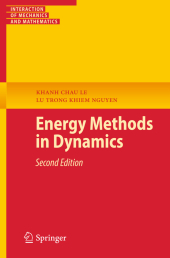 Neuerscheinungen 2014Stand: 2020-02-01 |
Schnellsuche
ISBN/Stichwort/Autor
|
Herderstraße 10
10625 Berlin
Tel.: 030 315 714 16
Fax 030 315 714 14
info@buchspektrum.de |

Lu Trong Khiem Nguyen, Khanh Chau Le
(Beteiligte)
Energy Methods in Dynamics
2. Aufl. 2014. xii, 413 S. 183 SW-Abb. 235 mm
Verlag/Jahr: SPRINGER, BERLIN; SPRINGER INTERNATIONAL PUBLISHING 2014
ISBN: 3-319-05418-X (331905418X)
Neue ISBN: 978-3-319-05418-6 (9783319054186)
Preis und Lieferzeit: Bitte klicken
Energy Methods in Dynamics is a textbook based on the lectures given by the first author at Ruhr University Bochum, Germany. Its aim is to help students acquire both a good grasp of the first principles from which the governing equations can be derived, and the adequate mathematical methods for their solving. Its distinctive features, as seen from the title, lie in the systematic and intensive use of Hamilton´s variational principle and its generalizations for deriving the governing equations of conservative and dissipative mechanical systems, and also in providing the direct variational-asymptotic analysis, whenever available, of the energy and dissipation for the solution of these equations. It demonstrates that many well-known methods in dynamics like those of Lindstedt-Poincare, Bogoliubov-Mitropolsky, Kolmogorov-Arnold-Moser (KAM), Wentzel-Kramers-Brillouin (WKB), and Whitham are derivable from this variational-asymptotic analysis.
This second edition includes the solutions to all exercises as well as some new materials concerning amplitude and slope modulations of nonlinear dispersive waves.
Part I Linear theory.- Part II Nonlinear theory.
From the book reviews:
"This textbook is addressed to teachers and students of mechanical and civil engineering. ... To help the reader to become more proficient, each chapter ends with exercises some of which can be solved effectively by using Mathematica. ... The main goal of this textbook is to help readers to acquire both a good grasp of the first principles from which the igoverning equations can be derived, and the adequate mathematical methods for their solving." (Vasile Marinca, zbMATH, Vol. 1303, 2015)


